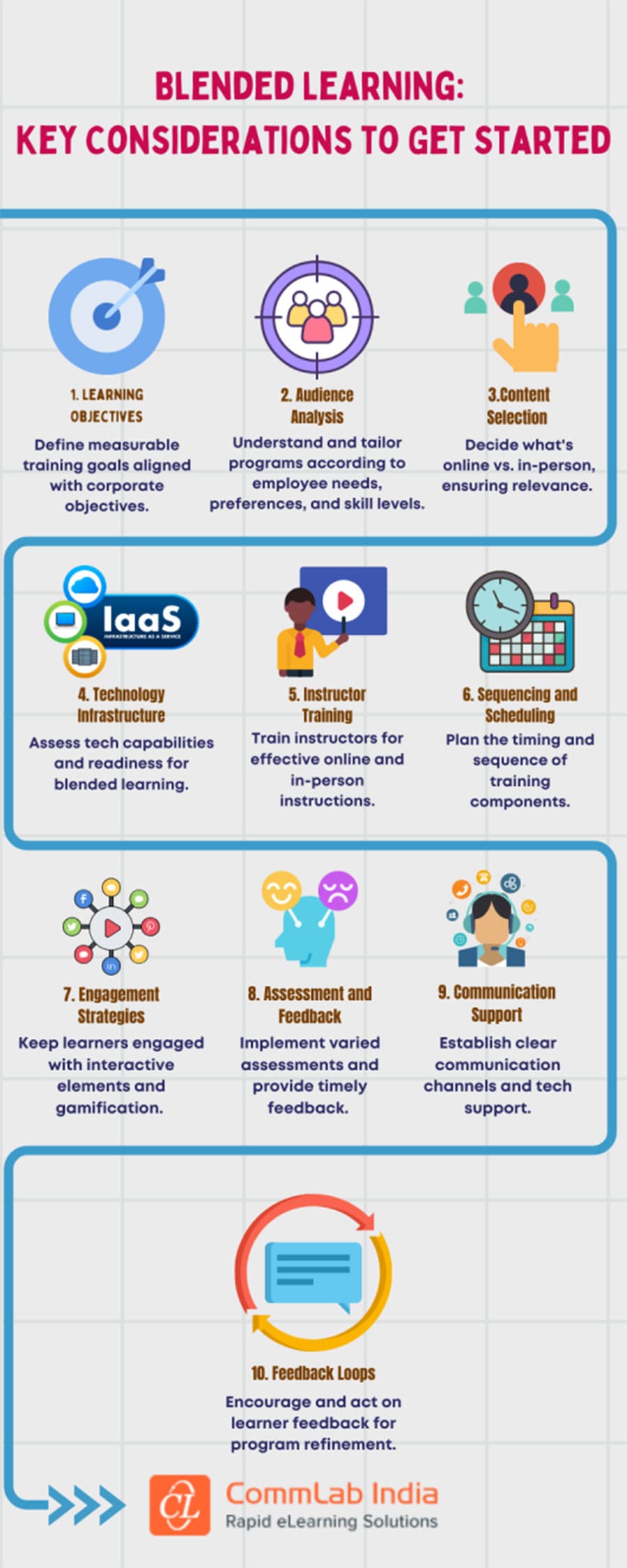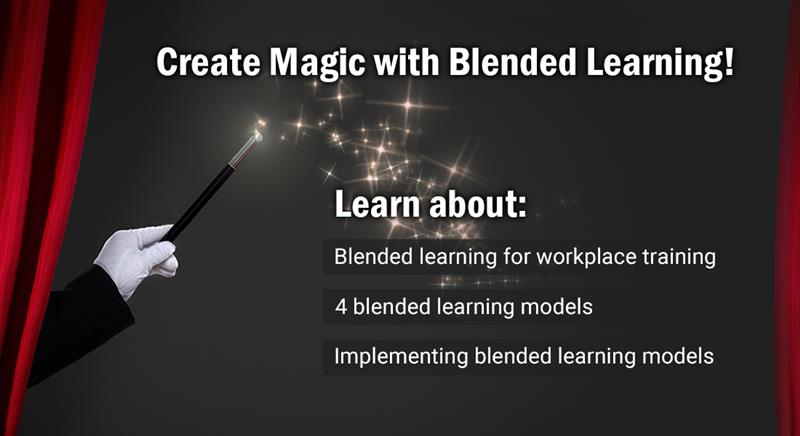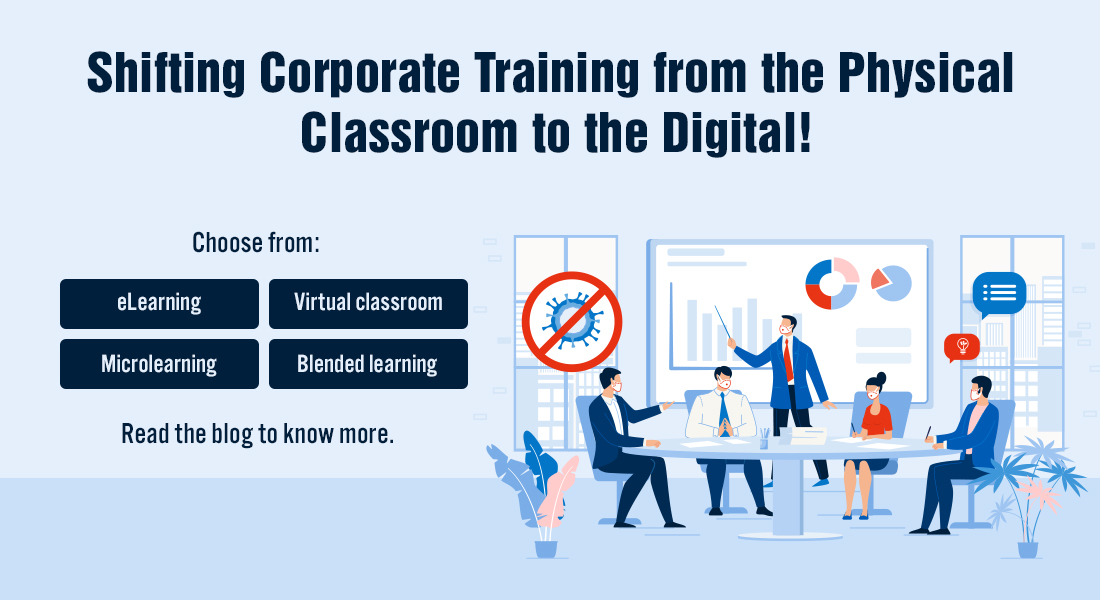How to Align Blended Learning Strategy with Business Goals [Infographic]
![How to Align Blended Learning Strategy with Business Goals [Infographic] How to Align Blended Learning Strategy with Business Goals [Infographic]](https://blog.commlabindia.com/hubfs/blogs/blended-learning-align-business-goals.jpg)
Choosing between online or classroom training, synchronous VILT, or asynchronous eLearning can be daunting for training managers. And why wouldn’t it be? The future growth of your employees hangs in the balance. The solution? Blended Learning! Blended learning strategy involves mixing up training formats such as eLearning, classroom ILT, VILT, social learning, and performance support. The outcome of this blend is a tailor-made learning strategy to fit your training requirements.
This blog talks about the key considerations when implementing and how to align blended learning strategy with business goals for sustainable growth.
What is Blended Learning and Why is it the Best Training Strategy?
Blended learning is a popular training strategy that combines online training and face-to-face classroom training to ensure heightened impact, engagement and convenience.
Blended Learning and Key Considerations
Blended learning provides a flexible and dynamic learning experience, catering to diverse learning styles and preferences within the workforce. Blended learning combines the accessibility and convenience of online learning with the engagement and interaction of traditional classroom settings. This versatility allows organizations to optimize training effectiveness, enhance employee engagement, and accommodate various learning needs, contributing to a more well-rounded and impactful corporate training program.
The key considerations to get started with blended learning include:
While these are the considerations that help you get started with the implementation, the first step to make blended learning a success is to focus on your business goals. You have to thoroughly analyze your training requirements and decide which training delivery formats are best suited to fulfill them and plan your blend accordingly.
Here is how you can go about planning your blended learning strategy to go with your organization’s business goals.
5 Steps to Align your Blended Learning Strategy with Business Goals
1. Recognize your Organization’s Long-Term Goals
Start by defining your goals before exploring training formats. Ask yourself: "What do I aim to achieve with this training?" Whether it's reducing costs, increasing revenue, or ensuring compliance, align your goals with your current status. Conduct a Training Need Analysis (TNA) to identify performance gaps, and if training is the solution, opt for a blended learning strategy. For instance, if your business goal is to increase revenue from a new product, address knowledge gaps with hands-on product demos and enhance negotiation skills through online simulation training.
Let’s go through an example here:
- Business goal: To increase revenue from a newly updated product
- Performance gaps (from feedback from sales reps and customers):
-
- Sales reps not very knowledgeable on what the updated product has to offer
- They are unable to negotiate with customers on the pricing
- Desired Improvement:
-
- Improved knowledge on the features of the new product version
- Better negotiation skills
- Strategy: A blended approach with hands-on product demonstration and online simulation training to hone their sales pitch
2. Conduct an Audit to Gather All Information on Current Training
While a TNA will help you determine the need for training and come up with an effective plan, it can’t be effectively implemented if you don’t have the necessary information to back it up. Conducting an audit will help you determine the current state of training content, resources, infrastructure, budget, and timelines.
Continuing with the example of product training, here is what you need to find during the audit:
1. Content
- Delivery method: Classroom or eLearning?
- Currency of information: Manuals, guides, or eLearning courses?
- Content gaps: Identify and quantify.
- Accessibility for sales reps in the field.
2. Resources
- Do you have instructors available to conduct classroom ILT sessions for hands-on product demonstrations?
- Can the instructors conduct sessions though virtual classrooms?
- Are Subject Matter Experts (SMEs) available for reviewing courses for accuracy?
- How much time can SMEs spend to provide updated information?
3. Infrastructure
- Do you have a Learning Management System? Does it allow remote access?
- Does the LMS support blended learning and offline learning?
- Do you have to license for a VILT platform? Does it allow remote access?
- Do you have the infrastructure (e.g. mobile devices) for remote learners?
4. Budget
- What is your current training budget?
- Can this budget accommodate a blended learning approach?
- How much more funds do you need to implement a successful blended learning program?
5. Timeline
- When should the new blended learning program rollout?
- What are the different developmental milestones?
→ Download Now: Blended Learning: A Guide to Boost Employee Performance [eBook]
3. Decide on the Training Formats for Blended Learning
After completing the audit, the next step involves strategic planning for blended learning, where you decide on the training formats – whether it's classroom ILT, VILT, eLearning, or microlearning. Contrary to a common misconception that blends ILT and eLearning, blended learning is not confined to these two formats. It can encompass various training methods tailored to specific contexts, creating an ideal training blend. Here are some examples:
Formal Training:
- Instructor-led classroom training
- eLearning curriculums
Self-directed Training:
- Microlearning modules
- eLearning courses
Just-in-time Training:
- Mobile learning
- Digital resources like simulations, animations, games, quizzes, etc.
Social Learning:
- Discussion boards
- Online forums
Performance Support:
- How-to guides
- Videos
- Job-aids
- Mobile apps
4. Strategize for an Appropriate Blended Learning Model
Blended learning is not confined to fixed combinations like eLearning followed by classroom ILT. Various formats can be flexibly combined within a blended learning strategy. Four popular models, according to the Christensen Institute, include:
1. Rotational Model: Learners rotate through eLearning, classroom ILT, and group activities in equal intervals.
2. Flipped Classroom: In flipped classroom, learners engage with eLearning or self-study outside class, using in-class time for assimilation or hands-on experience.
3. Flex Model: eLearning serves as the primary format, complemented by individual tutoring, mentoring, or group activities, tailored to individual needs.
4. Enriched Virtual Model: Online training precedes a mandatory ILT session, whether in a physical classroom or through VILT.
5. À La Carte Model: Classroom ILT is supplemented by online training, suitable for product training where concepts are covered in class, hands-on experience in workshops, and microlearning modules for performance support.
5. Plan to Offer Continuous Learning Opportunities
While often treated as an event, corporate training is ideally a continuous process. Blended learning facilitates ongoing learning with:
1. Microlearning Assets: Bite-sized learning nuggets accessible anytime, providing instant information in various formats like videos, audio podcasts, or infographics for performance support.
2. Social Learning Elements: Discussion boards, online communities, and forums for informal interaction with SMEs and peers. E-mentoring allows engagement with experts and thought leaders.
3. Mentoring Workshops: One-on-one mentoring sessions post formal training, connecting learners with instructors and professionals in the field.
4. Mobile Apps: Leveraging modern LMS mobile apps to offer remote workers convenient access to training anytime, anywhere via their mobile devices.
Summing it Up!
Blended learning can be a formidable training strategy when planned and implemented well. I hope this article gave you some insights on how you can come up with an action plan to get the most out of it. Focusing on the big picture, i.e., your ultimate business goals, in the best way to make blended learning work as your training strategy.
Want to know more about blended learning and how it can be used to boost your employees’ performance and skyrocket your business ROI? Download our eBook.







